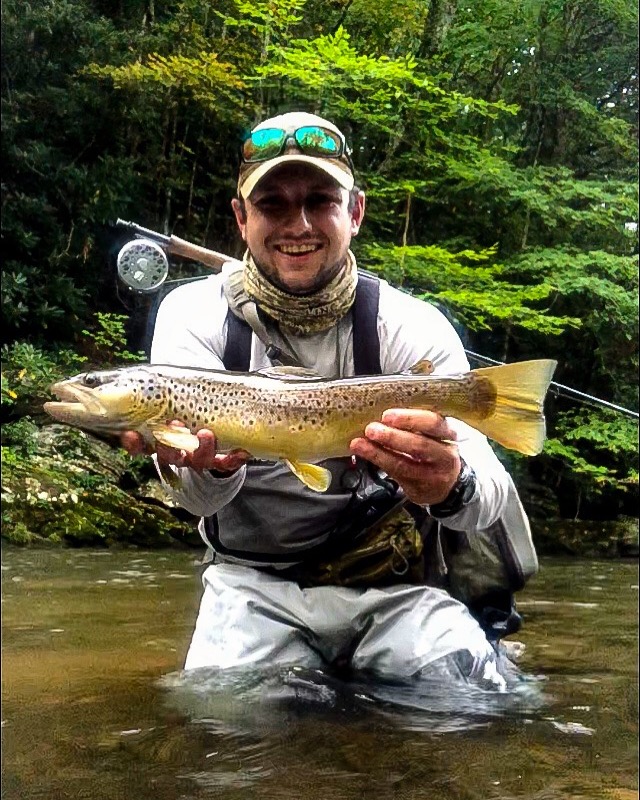A Brief History of Trout in Western North Carolina

It’s curious how trout as a gamefish species are one of the most popular for anglers to target, and yet at the same time are incredibly misunderstood. This is especially true when it comes to the history of trout fishing in Western North Carolina, which is as complex as it is beneficial for the trout angler to understand. I’m going to try and break down the history of the predominant wild trout species (brook, brown, and rainbow trout), their history within the state, and what the future holds for our trout fisheries here as a whole.
Trout first appeared in the Southern Appalachians approximately 10,000 or so years ago during the last ice age, in which the ancestors of modern day Arctic Char swam up rivers in the Southeastern US and were trapped within mountain watersheds as the glacier which covered half of North America at the time began to recede. In that time the Arctic Char that were trapped at higher elevation streams and lakes throughout the Appalachian mountain range evolved into what we know now as the brook “trout” (although technically, a species of char) that became the only species of salmonoid found naturally in freestone streams along the Eastern United States. The brook trout further evolved into two distinct subspecies, one of which was the Southern Appalachian Brook Trout, or speckled trout as we call them here, that thrived in the mountains of Virginia down to Georgia until after the Civil War. Post-war logging operations by predominantly northern logging companies contributed greatly to deforesting much of the Southern Appalachians. This resulted in streams carrying native populations of speckled trout to become neutralized due to their need of cold, exceptionally clean water that was no longer available. While they can still be found within our mountains today within the headwater portions of many watersheds; their native range is still under threat from increasing amounts of headwater streams becoming compromised by deforestation, housing developments, encroaching of non-native trout species, and overfishing.
Rainbow trout and brown trout were not introduced into the waters of Western North Carolina until the late 1800’s – early 1900’s, and their history is debated still by biologists and angling historians alike. What is agreed on is that the void left by the speckled trout was soon replaced with wild reproducing populations of both non-native rainbows and browns due to artificial stocking programs by both private entities and government agencies. Rainbow trout are originally native to the western side of the Rocky Mountains along the Pacific Rim as far south as parts of Mexico all the way into Canada, and even parts of Russia. Brown Trout are native originally to Europe and even parts of the Western reaches of Asia and Northern Africa in mountainous regions. Brown trout genetically speaking are descended from Atlantic Salmon, while rainbows are descended from various strains of Steelhead.
Rainbow trout have an estimated genetic diversity of over 75 different strains, which makes tracing the ancestors of the ones found in WNC to be rather difficult. It’s generally agreed that the rainbows that were introduced into the Southern Appalachians were first brought over from the McCloud River drainage in California, but there are unofficial oral traditions of the Kern River being an origin point as well. Brown trout were brought over from different parts of Europe, mainly the British Isles and Germany according to early 20th century oral sources. They quickly overtook many of the streams in Western North Carolina due to their ability to survive higher water temperatures/ levels of pollution than speckled trout. These factors led to the spread of both non-native rainbows and browns throughout the majority of the watersheds in WNC, especially through the re-expansion of forested areas throughout the 20th century.
Wild populations of all three species of trout are at a major crossroads as to whether our grandchildren and their children will be able to experience the thrill of catching their first wild or native trout in Western North Carolina. If anything can be learned from studying the history of trout here in the mountains, it is that man has done more to change and alter the course of the environment for both the good and the bad. It should never be underestimated how much damage can be done in such a short amount of time to our trout fisheries here, and we as anglers must take it upon ourselves to uphold the mantle of responsibility in ensuring that these fisheries will last for generations to come.
Ethan Hollifield is a member of a conservation organization called 2% For Conservation, Land O’ Sky Chapter of Trout Unlimited member, and a guide for Southern Appalachian Anglers.
Ethan’s publisher, The Angler Magazine, gave permission for LOS TU to reprint the article on our website and to use for youth education.

